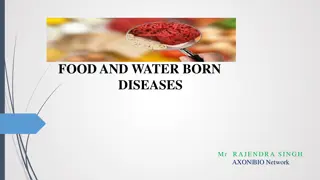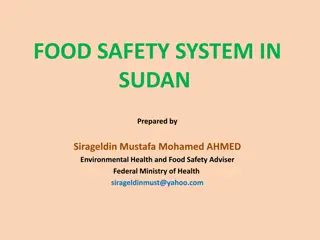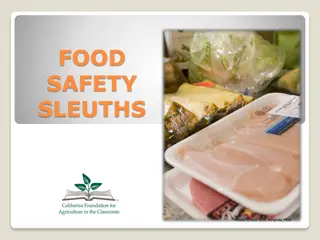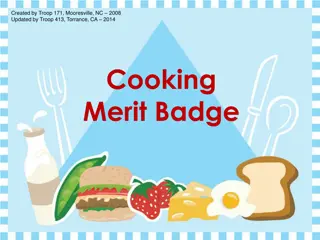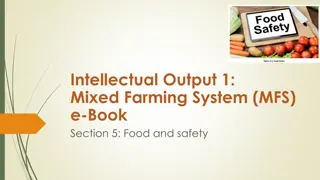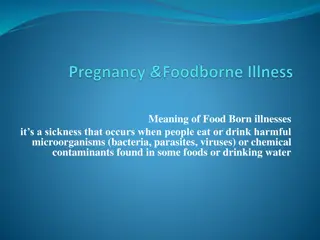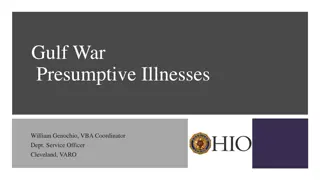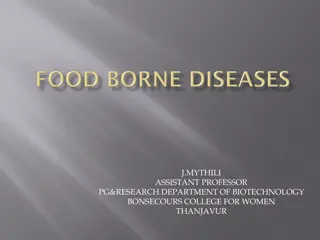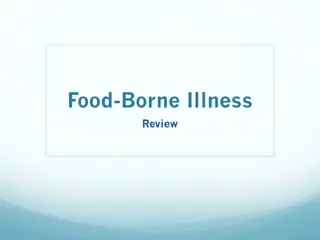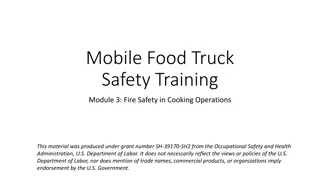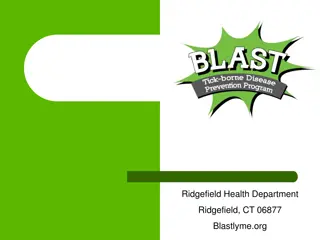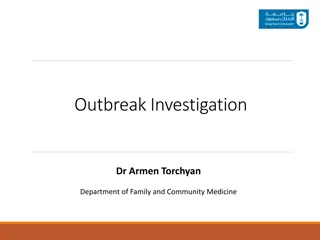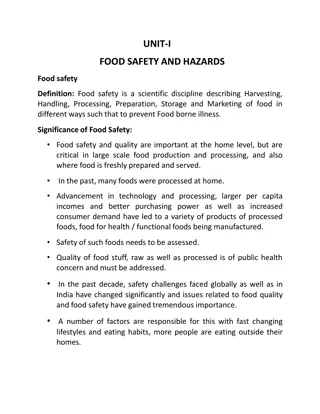Food Safety and Prevention of Food-borne Illnesses
An estimated 48 million Americans suffer from food-borne illnesses yearly, caused by harmful microorganisms due to poor food handling practices. Factors contributing to food-borne illnesses include improper cooking, inadequate storage, and cross-contamination. To prevent such illnesses, it is essential to follow food safety practices such as clean-cook-chill procedures, avoiding cross-contamination, and understanding the factors that contribute to bacteria growth during food preparation.
Uploaded on Sep 14, 2024 | 0 Views
Download Presentation

Please find below an Image/Link to download the presentation.
The content on the website is provided AS IS for your information and personal use only. It may not be sold, licensed, or shared on other websites without obtaining consent from the author. Download presentation by click this link. If you encounter any issues during the download, it is possible that the publisher has removed the file from their server.
E N D
Presentation Transcript
An estimated 48 million Americans suffer from food-borne illness (food poisoning defined as an illness caused by consuming contaminated food or beverages.) every year. Food-borne illness may be mild(flu like symptoms: diarrhea, nausea, vomiting, stomach cramps) (1-2 days) or severe (hospitalization or death). Children, pregnant women, elderly & people with chronic illness are most at risk
Most food-borne illness can be traced to harmful microorganisms tiny living creatures visible only through a microscope. Types/examples: Listeria, salmonella, e coli, campylobacter, botulism, etc. Poor food handling practices allow harmful micro-organisms to growand spread.
Pair/share: Find one example we have control over? 40% improper cooking of foods 21% holding time for food (time between prep and serving of food) 20% infected persons touching food 16% inadequate cooking of foods 16% improper food storage 12% inadequate heating of food 11% contaminated 7% cross contamination 7% improper cleaner used 4% use of leftovers
Sohow can we prevent & reduce the chances of bacteria growth while cooking in this class? http://www.youtube.com/watch?v=YH8g m7xm- 7Y&playnext=1&list=PL792859FC2DDD6 1B2&feature=results_video
Clean-Cook-Chill-Contain Cross- Contamination Wash hands in between touching different foods Thoroughly cook all meat Keep food chilled Avoid cross contamination
F 1. Food- especially food high in protein A 2. Acidity level especially from 4.6 to 14 T 3. Temperature 41 degrees to 135 degrees (DANGER ZONE) T 4. Time more time allows enough bacteria growth to cause illness O 5. Oxygen thrives with oxygen M 6. Moisture thrives in moist environments
(defined as a food item that would support rapid bacterial growth) Any food of Animal origin Meat: beef, chicken, fish, eggs Dairy products: milk, cheese, yogurt Plant origin Cooked starches like oatmeal, rice, potatoes Cooked vegetables Tofu Sprouts Cut Melons, cut tomatoes, and cut leafy green vegetables Garlic or herbs bottled in oil
1. Avoid handling food when you are ill (diarrhea, vomiting, etc.) or if you have cuts or sores on your hands. (use gloves if needed) Wash hands before food preparation, after sneezing, coughing, using rest room , touching face or hair, and handling raw meat/eggs. Keep hair away from face. Bring hat or hair ties for hair. Wear clean clothes/apron (dirty clothing carries bacteria) Avoid tasting food while cooking licking of fingers is prohibited. One taste with a clean spoon only!
Use hot, soapy water on dishes Don t wipe hands on dish towel use paper towels so dishes don t get bacteria Sanitize & wash cutting board that has had meat before cutting anything else or use separate cutting boards(cross contamination ) Keep your kitchen pest free. A house fly landing on your food can spread salmonella and staph bacteria
Use clean equipment and supplies Use equipment for it s intended use Do not touch food with hands if tongs, a fork, or a serving spoon can be used. Wipe electrical appliances do not immerse in water!
Pair/Share: What is the difference between Cleaning and Sanitizing? Cleaning: removing visible dirt, soil, dust, or food waste. Sanitizing: reducing the number of microorganisms, bacteria on a surface to safe levels with an ammonia or bleach solution Cross-Contamination: letting micro-organisms spread from one food/surface into another
https://www.youtube.com/watch?v=Xm_X5LJmrbw Keep work areas clean Keep raw and cooked products separate during food preparation. After using cutting boards and tools for cutting raw meat or eggs, wash thoroughly and disinfect. Keep separate cutting boards for raw foods and cooked foods Never place cooked meat on a plate that held raw meat. Store fresh meat products on trays on the lowest shelf in the refrigerator.
Danger Zone: 41-135 degrees Keep cold foods at 40 degrees F or below. Keep hot foods at 136 degrees or higher. Move food through the danger zone within a 2 hour time period! Thaw frozen foods in the refrigerator(not on the counter) If you thaw foods in the microwave cook immediately. Maintain the refrigerator temperature at 38 to 40 degrees F. Cool foods before refrigerating or you will increase the temperature of your refrigerator! https://www.youtube.com/watch?v=T5C335jleZA
Ready-to-eat food Store raw meat below ready to eat foods. This order is suggested to prevent raw food juices from dripping on ready-to-eat food. The order of food placement is based on the minimal internal cooking temperature of each food. Whole fish and seafood Whole pieces of beef and pork Ground beef Poultry
Wash tops of cans before opening them to keep dust and bacteria out of foods. Do not use dented, leaking or swollen canned goods. Wash fresh fruits and vegetables thoroughly to flush away pesticides and dirt before preparation.
Cooking food is not only to enhance flavor but it also helps to kill bacteria Proper cooking temperatures: in order to tell if meat is properly and thoroughly cooked 165 degrees and above- chicken, pork, stuffing, casseroles, leftovers 155 degrees and above ground meat: beef and sausages 145 degrees and above lamb, fish, beef, eggs 135 degrees and above - ready to eat foods (hot dogs) and vegetables
Clean Cook Chill Contain cross- contamination Examples: As you watch this video list the safety mistakes https://www.youtube.com/watch?v=IA8IW5abQTg&featur e=youtu.be
Grease Fires https://www.youtube.com/watch?v=PyrbiU0s B4s
Group work: Give at least 2 examples that will keep you safe in your kitchen for each topic listed





